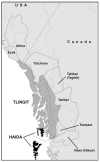Clan, language, and migration history has shaped genetic diversity in Haida and Tlingit populations from Southeast Alaska
- PMID: 22549307
- PMCID: PMC4335652
- DOI: 10.1002/ajpa.22068
Clan, language, and migration history has shaped genetic diversity in Haida and Tlingit populations from Southeast Alaska
Abstract
The linguistically distinctive Haida and Tlingit tribes of Southeast Alaska are known for their rich material culture, complex social organization, and elaborate ritual practices. However, much less is known about these tribes from a population genetic perspective. For this reason, we analyzed mtDNA and Y-chromosome variation in Haida and Tlingit populations to elucidate several key issues pertaining to the history of this region. These included the genetic relationships of Haida and Tlingit to other indigenous groups in Alaska and Canada; the relationship between linguistic and genetic data for populations assigned to the Na-Dene linguistic family, specifically, the inclusion of Haida with Athapaskan, Eyak, and Tlingit in the language family; the possible influence of matrilineal clan structure on patterns of genetic variation in Haida and Tlingit populations; and the impact of European entry into the region on the genetic diversity of these indigenous communities. Our analysis indicates that, while sharing a "northern" genetic profile, the Haida and the Tlingit are genetically distinctive from each other. In addition, Tlingit groups themselves differ across their geographic range, in part due to interactions of Tlingit tribes with Athapaskan and Eyak groups to the north. The data also reveal a strong influence of maternal clan identity on mtDNA variation in these groups, as well as the significant influence of non-native males on Y-chromosome diversity. These results yield new details about the histories of the Haida and Tlingit tribes in this region.
Copyright © 2012 Wiley Periodicals, Inc.
Figures




References
-
- Ackerman RE. Earliest stone industries on the North Pacific coast of North America. Arctic Anthropol. 1992;29:18–27.
-
- Ackerman RE. Ground Hog Bay 2. In: West FH, editor. American beginnings: prehistory and paleoecology of Beringia. University of Chicago Press; Chicago: 1996. pp. 424–430.
-
- Ames KM, Maschner HDG. Peoples of the northwest coast. Their archaeology and prehistory. Thames and Hudson; London: 1999.
-
- Anderson S, Bankier AT, Barrell BG, de Bruijn MH, Coulson AR, Drouin J, Eperon IC, Nierlich DP, Roe BA, Sanger F, Schreier PH, Smith AJ, Staden R, Young IG. Sequence and organization of the human mitochondrial genome. Nature. 1981;290:457–465. - PubMed
Publication types
MeSH terms
Substances
Grants and funding
LinkOut - more resources
Full Text Sources

